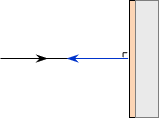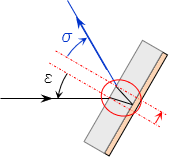3. Reflection
Reflection happens when at least a portion of a light ray is returned from the interface rather than continuing entirely though the second medium. Highly polished surfaces will have some degree of reflection, some are more efficient than others. One of the most efficient is a silver coating on a support medium.
The reflective coating can be on the front or back of the support medium. Figure H-4 shows a flat first-surface mirror with the reflective material on the front.
 |
| Figure H-4 First-Surface Mirror |
For a flat reflector, the incidence angle, ε, and reflection angle, σ, are equal (think of a bank shot in pool or billiards with no spin on the cue ball). If the light ray intersects the reflector at 90°, Figure H-5, it is reflected back along its original path.
 |
| Figure H-5 Reversed Reflection |
First surface mirrors are used where distortion free sight lines are important because light rays are affected only by reflection. A reflective coating on the back of a glass plate means the light ray must pass through the glass first causing it to be refracted. Once reflected, it is refracted again when it emerges from the glass, Figure H-6.
 |
| Figure H-6 Back-Surface Mirror |
While the incident and reflection angles are correct, the light ray has been displaced because of the refractions.
Unless specifically designed not to, most reflective coatings will allow some light to pass through. An example is a one-way mirror - on one side of the mirror a person sees only their reflection but their image passes through and is visible to observers on the other side. Their image, however, does not pass back through the mirror.